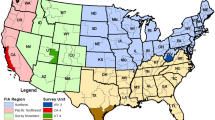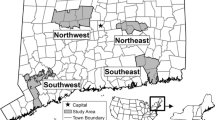Abstract
Urban forest inventories are conducted to obtain important information regarding trees and the ecosystem services they provide in the urban environment. This information is derived from a sample of ground plots within which all trees are measured. It is common that some of the selected sample plots are unable to be measured, primarily due to lack of permission to access privately owned lands. At a minimum, nonresponse results in decreased sample sizes and eroded confidence in information derived from the inventory. Further, concern is raised regarding sample bias and its associated effects on analytical outcomes when the nonresponse cannot be considered random with respect to population characteristics. In this study, data from urban forest inventories conducted in 33 cities across the U.S. were used to assess amounts of nonresponse present. Total amounts of nonresponse ranged from 1.7% in Madison, WI to 36.8% in Bridgeport, CT. Examinations of potential nonrandom occurrence of nonresponse were conducted using plot location information in conjunction with various digital map layers and notable trends were found in relation to median income, median age, percent canopy cover, percent residential ownership, and percent impervious surface. In contrast, there appeared to be little correlation between nonresponse and percent of English-only speaking households. As a caveat to overly broad interpretation, in Houston, TX it was shown there was no correlation between nonresponse and median income and the relationship with percent canopy cover was opposing that of the general trend. The magnitude of potential nonresponse bias in estimates of tree biomass and tree frequency was investigated by substituting predicted values for nonresponse plots, with underestimation of both attributes ranging from approximately 1% to 10%. Thus, urban forest inventory practitioners should evaluate city-specific circumstances to effectively mitigate potential bias resulting from nonresponse in the sample.





Similar content being viewed by others
References
Bechtold WA, Scott CT (2005) The forest inventory and analysis plot design. In: Bechtold WA, Patterson PL (eds) The enhanced forest inventory and analysis program - national sampling design and estimation procedures (Gen. Tech. Rep. SRS-80) USDA Forest Service, Southern Research Station, Asheville NC, pp 37-52
Coulston JW, Moisen GG, Wilson BT, Finco MV, Cohen WB, Brewer CK (2012) Modeling percent tree canopy cover—A pilot study. Photog Eng Rem Sens 78(7):715–727
Dewitz J, U.S. Geological Survey (2021) National Land Cover Database (NLCD) 2019 Products (ver. 2.0, June 2021): U.S. Geological Survey data release. https://doi.org/10.5066/P9KZCM54
Domke GM, Woodall CW, Walters BF, McRoberts RE, Hatfield MA (2014) Strategies to compensate for the effects of nonresponse on forest carbon baseline estimates from the national forest inventory of the United States. For Ecol Manag 315:112–120
Edgar CB, Nowak DJ, Majewsky MA, Lister TW, Westfall JA, Sonti NF (2021) Strategic national urban forest inventory for the United States. J For 119(1):86–95
Edgar CB (2022) Urban forest inventory and analysis. In: Westfall JA, Coulston JW, Moisen, GG, Andersen H-E (comps) Sampling and estimation documentation for the enhanced forest inventory and analysis program: 2022 (Gen. Tech. Rep. NRS-GTR-207) USDA Forest Service, Northern Research Station, Madison WI, pp 22–34
Farm Service Agency (2017) National Agriculture Imagery Program (NAIP) information sheet. https://www.fsa.usda.gov/Assets/USDA-FSA-Public/usdafiles/APFO/support-documents/pdfs/naip_infosheet_2017.pdf. Accessed 9 Aug 2023
Fattorini L, Franceschi S, Maffei D (2013) Design-based treatment of unit nonresponse in environmental surveys using calibration weighting. Biomet J 55:925–943
Fattorini L (2015) Design-based methodological advances to support national forest inventories: a review of recent proposals. iFor-Biogeosci For 8(1):6
Goeking SA, Patterson PL (2013) Stratifying to reduce bias caused by high nonresponse rates: A case study from New Mexico’s forest inventory (Res. Note RMRS-RN-59). USDA Forest Service, Rocky Mountain Research Station, Fort Collins, CO
Gormanson DD, Pugh SA, Barnett CJ, Miles PD, Morin RS, Sowers PA, Westfall JA (2018) Statistics and quality assurance for the Northern Research Station Forest Inventory and Analysis Program. (Gen. Tech. Rep. NRS-178). USDA Forest Service, Northern Research Station, Newtown Square, PA
Irga PJ, Burchett MD, Torpy FR (2015) Does urban forestry have a quantitative effect on ambient air quality in an urban environment? Atmospheric Environ 120:173–181
Kong F, Sun C, Liu F, Yin H, Jiang F, Pu Y, Cavan G, Skelhorn C, Middel A, Dronova I (2016) Energy saving potential of fragmented green spaces due to their temperature regulating ecosystem services in the summer. Appl Energy 183:1428–1440
Morgenroth J, Östberg J (2017) Measuring and monitoring urban trees and urban forests. In: Fini A (ed) Ferrini F, Konijnendijk van den Bosch CC. Routledge Handbook of Urban Forestry. Taylor and Francis Group, London, pp 33–48
Magnussen S, Stinson G, Boudewyn P (2017) Updating Canada’s national forest inventory with multiple imputations of missing contemporary data. For Chron 93(3):213–225
McRoberts RE (2003) Compensating for missing plot observations in forest inventory estimation. Can J For Res 33(10):1990–1997
Nowak DJ, Dwyer JF (2007) Understanding the benefits and costs of urban forest ecosystems. In: Kuser J (ed) Urban and Community Forestry in the Northeast. Springer Science and Business Media, New York, pp 25–46
Nowak DJ, Hoehn RE, Crane DE, Stevens JC, Walton JT, Bond J (2008) A ground-based method of assessing urban forest structure and ecosystem services. Arboric Urban for 34(6):347–358
Nowak DJ (2020) Understanding i-Tree: summary of programs and methods (Gen. Tech. Rep. NRS-200). USDA Forest Service, Northern Research Station, Madison, WI. https://doi.org/10.2737/NRS-GTR-200
Östberg J, Wiström B, Randrup TB (2018) The state and use of municipal tree inventories in Swedish municipalities–results from a national survey. Urban Ecosyst 21(3):467–477
Patterson PL, Coulston JW, Roesch FA, Westfall JA, Hill AD (2012) A primer for nonresponse in the US forest inventory and analysis program. Environ Monit Assess 184(3):1423–1433
Särndal CE, Lundström S (2005) Estimation in surveys with nonresponse. John Wiley and Sons, Chichester
Scholz T, Hof A, Schmitt T (2018) Cooling effects and regulating ecosystem services provided by urban trees—novel analysis approaches using urban tree cadastre data. Sustainability 10(3):712
Scott CT, Bechtold WA, Reams GA, Smith WD, Westfall JA, Hansen MH, Moisen GG (2005) Sample-based estimators used by the forest inventory and analysis national information management system. In: Bechtold WA, Patterson PL (eds) The enhanced forest inventory and analysis program - national sampling design and estimation procedures (Gen. Tech. Rep. SRS-80) USDA Forest Service, Southern Research Station, Asheville NC, pp 43-67
U.S. Census Bureau (2021) 2015–2019 American Community Survey 5-year Estimates [Geodatabase]. https://www2.census.gov/geo/tiger/TIGER_DP/2019ACS/ACS_2019_5YR_BG.gdb.zip. Accessed 15 Aug 2022
U.S. Forest Service (2019) Field data collection procedures for urban FIA plots, version 9.0. https://www.fia.fs.usda.gov/program-features/urban/field-guides/national/National_Urban_FIA_FG_9.1.pdf. Accessed 30 Aug 2022
Westfall JA, Edgar CB (2022) Addressing nonresponse bias in urban forest inventories: an estimation approach. Front For Glob Change 117. https://doi.org/10.3389/ffgc.2022.895969
Westfall JA, Schroeder TA, McCollum JM, Patterson PL (2022) A spatial and temporal assessment of nonresponse in the national forest inventory of the U.S. Environ Monit Assess 194:530
Westfall JA (2022) An estimation method to reduce complete and partial nonresponse bias in forest inventory. Eur J for Res. https://doi.org/10.1007/s10342-022-01480-6
Funding
Support for this effort was provided in part by Minnesota Agricultural Experiment Station Project MIN-42–078 and USDA Forest Service Projects—FIA Forest Biometrics Research and Program Support (RJVA 20-JV-11242305–018) and Forest Inventory and Analysis (FIA) Analytical Support (CRA 20-CR-11242305–082).
Author information
Authors and Affiliations
Contributions
James A. Westfall: Conceptualization, Formal analysis, Writing—Original Draft. Christopher B. Edgar: Conceptualization, Methodology, Writing—Review & Editing. Rebekah Zehnder: Resources, Writing—Review & Editing.
Corresponding author
Ethics declarations
Competing interests
The authors declare no competing interests.
Rights and permissions
About this article
Cite this article
Westfall, J.A., Edgar, C.B. & Zehnder, R. Relationships between population characteristics and nonresponse in urban forest inventories. Urban Ecosyst 27, 613–623 (2024). https://doi.org/10.1007/s11252-023-01467-0
Accepted:
Published:
Issue Date:
DOI: https://doi.org/10.1007/s11252-023-01467-0




